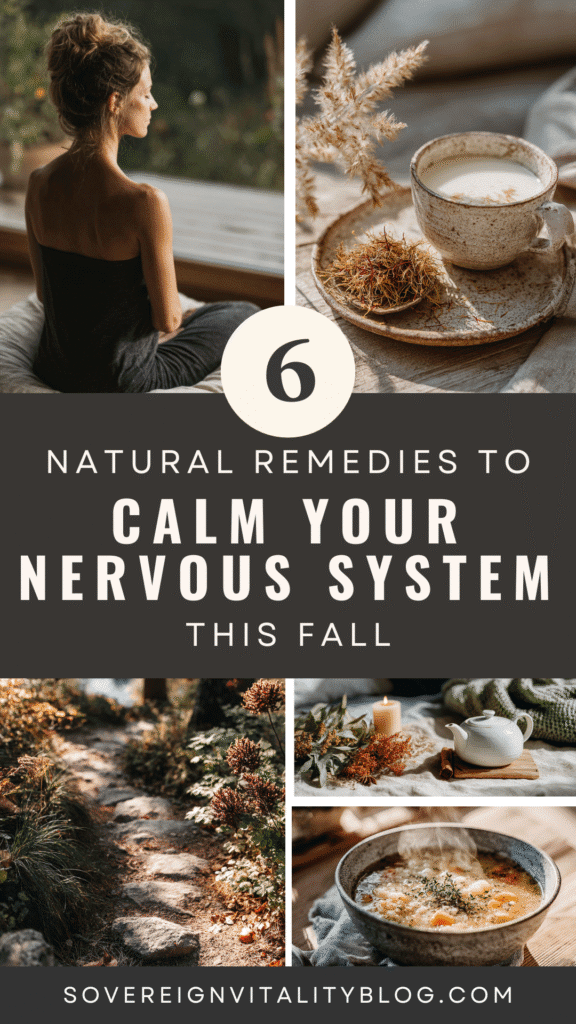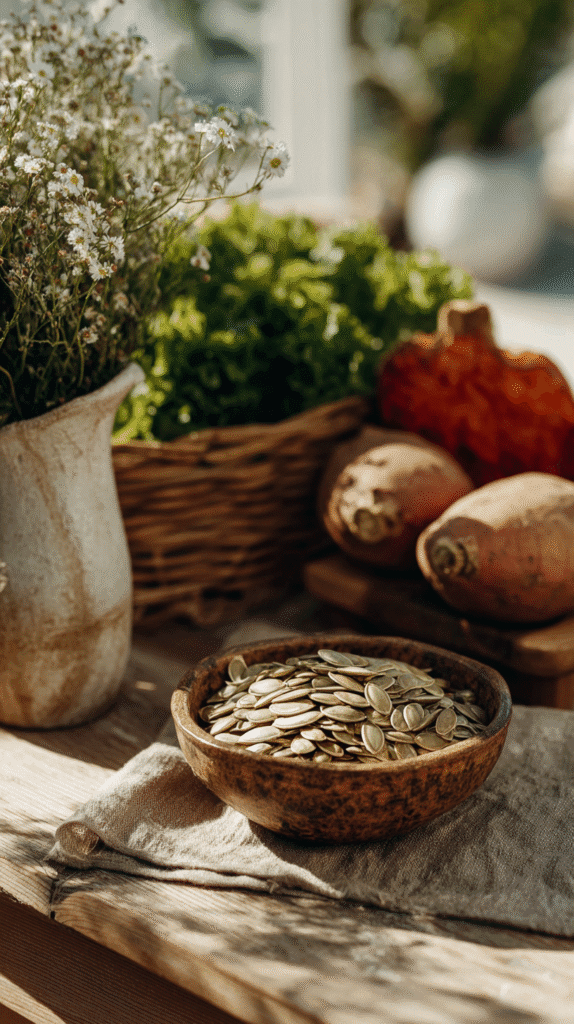This post may contain affiliate links, including those from Amazon Associates. If you make a purchase through these links, I may earn a commission at no additional cost to you. Learn more about our affiliate policy.
The arrival of fall often carries with it crispness in the air, the earlier sunsets, the steady return of schedules after summer’s looseness. These changing rhythms can stir our nervous systems in ways we may not expect.
I’ve noticed in myself that while fall feels grounding in its own way, it can also bring an undercurrent of stress.
The transition to cooler days, the ramping up of responsibilities, and the natural drop in daylight hours create pressure that lands squarely on the body’s stress response.

When that stress lingers, the nervous system begins to hum at a higher pitch than it should.
The good news is that fall also offers us tools for recalibration. Nature hands us herbs, nourishing foods, and quiet rituals that can soften the edges of stress and remind us of our sovereignty in how we care for ourselves.
These are six natural remedies that I return to when the season feels like too much.
Lemon Balm and Chamomile for Calm Evenings

As the days shorten, I find myself reaching more often for warm herbal teas. Lemon balm has long been studied for its ability to soothe anxiety and ease tension.
Chamomile, with its gentle floral notes, has been a trusted ally for centuries, thanks to its flavonoid apigenin that helps the body relax into rest.
Together, they create a kind of evening balm, a way of telling the body that it is safe to let go. On fall nights, I sometimes add a pinch of cinnamon or cardamom to my chamomile tea. The spices deepen the sense of coziness, wrapping me in a warmth that feels both seasonal and restorative.
If you’ve been searching for a bedtime practice that truly unwinds your body, you might also enjoy my guide to natural sleep remedies.
These herbal tea blends are just the beginning of what plants can offer.
Magnesium-Rich Seasonal Foods

Magnesium is often called nature’s calm mineral, and for good reason. It supports neurotransmitters like GABA that help the nervous system relax, while also easing muscle tension.
I used to think of it only in supplement form, but fall offers such an abundant spread of magnesium-rich foods that it’s easy to bring it to the table.
Pumpkin seeds are one of my favorites, tiny but powerful. I roast them with a little sea salt and olive oil, and they become the perfect afternoon snack.
Sweet potatoes, leafy greens, and squash are all seasonal sources too, making fall meals both comforting and calming.
I’ve noticed that weaving magnesium into my meals feels less like “taking a supplement” and more like honoring what my body is asking for during this season.
For more inspiration, you can explore my full guide to magnesium-rich foods that help ease stress and support steady energy.
Adaptogens and Gentle Herbal Supplements

Fall is a time when many of us crave steadiness. Adaptogens like saffron and L-theanine offer just that, helping balance mood and nervous system response.
Saffron has a rich history in supporting emotional health, and when I stir it into warm milk on chilly evenings, it feels almost ceremonial.
Valerian root and passionflower are also long-trusted herbal supports for nervous system stress, especially when sleep becomes disrupted.
While valerian can sometimes feel too strong for daytime, I find it useful before bed when my thoughts are restless. Passionflower, with its subtle sweetness, works beautifully as a tea any time the mind feels overstimulated.
As always, it’s best to start gently and notice how your body responds. For me, these herbs don’t “fix” stress, but they open the door to a deeper calm that was waiting underneath.
Breathwork and Gentle Movement

When the nervous system is overstimulated, one of the quickest ways back to calm is through the breath.
I’ve been practicing the 4-7-8 breathing technique for years: inhale for four, hold for seven, exhale for eight. Just a few rounds leave me feeling like I’ve set down a heavy bag I didn’t know I was carrying.
Movement helps too, but not in the way we often think. Fall is not the season where I want to push myself through high-intensity workouts.
Instead, I lean into slow yoga flows, Tai Chi, or even just a simple stretching session on my living room floor. On crisp afternoons, I step outside for a walk among the changing leaves, letting the colors themselves work their magic on my nervous system.
If this resonates, you may find comfort in my post on daily resets that restore calm. Sometimes it’s the smallest practices that have the biggest impact.
Nature Immersion and Forest Bathing

Few things regulate the nervous system as effectively as time in nature. There’s an ease that settles into the body when we’re surrounded by trees, when our senses are tuned to the earthy scent of soil and the sound of leaves underfoot.
Fall, with its vivid colors and cool breezes, is a season that practically invites us outdoors. I try to take at least one mindful forest bathing walk each week where I leave my phone behind and let myself notice.
The texture of a leaf, the sound of acorns crunching, the way the air feels fresher in my lungs, these small details become anchors that remind my nervous system it is safe. You may even want to create stunning dried leaf crafts with your findings!
The Japanese practice called shinrin-yoku, or forest bathing, formalizes this kind of nature immersion. It doesn’t have to be complicated. Simply being present outdoors is enough to soften stress.
Sensory Relaxation With Aromatherapy

When the evenings turn crisp, I cue calm in my body and mind through scents like cedarwood essential oil in my diffuser while I brew tea. This sends signals of safety to my nervous system.
Twenty to thirty minutes is often enough to change the tone of the room, and my body follows.
For effortless, on-the-go support, keep calming essential oil roll-ons within reach to give my senses a boost when my mood is low. A quick sweep across pulse points and three slow breaths help me reset.
Stress-Lowering Whole Foods

What we eat can either fan the flames of stress or gently calm them. Anti-inflammatory, nutrient-dense foods help regulate cortisol levels and provide steady energy. In fall, I lean heavily into soups and grain bowls, dishes that are both hearty and balancing.
A simple root vegetable soup with carrots, parsnips, and sweet potatoes can be grounding. Adding omega-3–rich fish, fermented foods like kimchi, or beans and lentils to meals creates a nutrient profile that steadies the nervous system.
I also find that eating seasonally, choosing what the earth is offering at this time, naturally harmonizes my body with the rhythm of fall. You can find more ideas for cozy fall clean eating meal prep recipes here.
If you’re looking to reset your mornings with food and rhythm, my post on calming morning routines offers inspiration for starting the day in a way that supports balance all day long.
Weaving These Remedies into a Fall Routine
What I’ve learned is that none of these remedies need to stand alone. They weave together into a rhythm that nourishes the nervous system across the day.
In the morning, magnesium-rich foods like pumpkin seeds or a hearty sweet potato breakfast bowl can set the tone.
A brisk walk outside brings in the crisp clarity of fall air.
Midday, a cup of lemon balm tea paired with a few rounds of 4-7-8 breathing can reset a tense system.
Evening invites deeper supports like saffron-spiced milk, valerian tea, or a few minutes of gentle stretching before sleep.
Fall doesn’t have to be a season of overwhelm. With these remedies, it becomes a season of recalibration, and a chance to align more closely with nature and remember that sovereignty in how we care for ourselves is always within reach.



